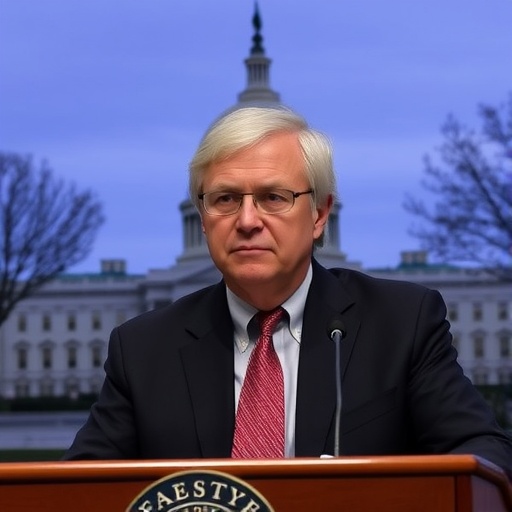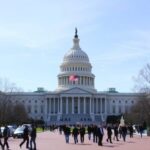U.S. Government Shutdown Persists: Speaker Johnson Warns of Record Duration Amid Healthcare Cuts and CDC Layoffs
In a stark revelation that has sent shockwaves through Washington and beyond, House Speaker Mike Johnson warned on Thursday that the ongoing Government Shutdown could etch itself into history books as the longest ever, surpassing the 35-day impasse of 2018-2019. As negotiations remain deadlocked over deep Healthcare Cuts and funding disputes, federal agencies are reeling from the fallout, with CDC Layoffs already impacting the nation’s public health defenses at a time when infectious disease threats loom large.
The shutdown, now in its 28th day, stems from partisan clashes in Congress over a massive spending bill. Democrats decry proposed slashes to Medicaid and other health programs as ruthless, while Republicans argue they’re essential for fiscal responsibility. With no resolution in sight, the human and economic costs are mounting rapidly, affecting everything from national parks to airport security and, most alarmingly, public health infrastructure.
Speaker Johnson’s Ominous Prediction Fuels Shutdown Fears
House Speaker Mike Johnson, R-La., dropped the bombshell during a tense press conference on Capitol Hill, his voice laced with frustration as he addressed reporters. “This Government Shutdown isn’t just a hiccup; it’s barreling toward becoming the longest in our nation’s history,” Johnson stated. “If we don’t bridge this divide soon, we’re looking at weeks, possibly months, of paralysis that no American deserves.”
Johnson’s comments come as the shutdown eclipses previous records in duration and scope. The current standoff began on October 1, triggered by disagreements on a $1.2 trillion omnibus bill that includes provisions for border security, disaster aid, and crucially, healthcare funding. Republicans, holding a slim majority in the House, have pushed for at least $100 billion in Healthcare Cuts to programs like the Affordable Care Act subsidies and rural hospital support, citing skyrocketing national debt exceeding $35 trillion.
Historical context underscores the gravity: The 2018-2019 shutdown, the previous record-holder at 35 days, cost the economy an estimated $11 billion in lost productivity, according to the Congressional Budget Office (CBO). Analysts at the Brookings Institution warn that this iteration could double that figure if it stretches beyond 60 days, with ripple effects hitting low-income families hardest through delayed benefits and furloughed workers.
Behind the scenes, negotiations have been fraught. Senate Majority Leader Chuck Schumer, D-N.Y., fired back at Johnson’s remarks, accusing Republicans of “playing politics with people’s lives.” In a floor speech, Schumer said, “These Healthcare Cuts aren’t savings; they’re sabotage. We’re talking about denying coverage to millions who rely on Medicaid expansions.” The impasse highlights deep ideological rifts, with progressives vowing to block any bill that trims social safety nets, while fiscal conservatives refuse to budge without concessions.
Healthcare Cuts Ignite Fierce Partisan Battle in Congress
At the epicenter of the Government Shutdown lies a contentious debate over Healthcare Cuts, with proposed reductions totaling $150 billion over the next decade. The Republican-led bill targets inefficiencies in Medicare reimbursements and caps funding for preventive care initiatives, aiming to redirect savings toward defense spending and tax relief. Critics, including the American Medical Association (AMA), argue these moves could lead to 2.3 million uninsured Americans by 2025, per a recent Urban Institute study.
One flashpoint is the proposed 15% cut to the Centers for Medicare & Medicaid Services (CMS) budget, which oversees health insurance for over 140 million people. “This isn’t just numbers on a page,” said Dr. Elena Ramirez, a policy expert at the Kaiser Family Foundation. “We’re talking about hospitals closing doors in underserved areas and patients skipping treatments because costs skyrocket.” Ramirez highlighted data showing rural communities, already strained, could see emergency room wait times double if funding dries up.
Democrats have countered with amendments to protect vulnerable populations, including expanded telehealth services post-COVID. Yet, House Republicans, buoyed by endorsements from the Heritage Foundation, view these as budgetary bloat. A leaked memo from GOP leadership revealed plans to tie healthcare reforms to immigration enforcement, further complicating talks. As one anonymous Senate aide put it, “It’s like herding cats—everyone’s dug in, and no one’s backing down.”
The broader implications extend to pharmaceutical pricing and mental health services. The bill’s clause limiting FDA approvals for generic drugs has drawn ire from patient advocacy groups like the AARP, who estimate it could raise out-of-pocket costs by 20% for seniors. With midterm elections looming, both parties are leveraging the shutdown for political gain, turning a fiscal crisis into a high-stakes showdown.
CDC Layoffs Cripple Public Health Amid Rising Threats
Nowhere is the Government Shutdown‘s toll more acutely felt than in public health, where CDC Layoffs have decimated the workforce at the Centers for Disease Control and Prevention (CDC). Over 8,000 non-essential employees—about 45% of the agency’s staff—have been furloughed, halting critical surveillance programs and vaccine distribution efforts.
Dr. Rochelle Walensky, former CDC director, issued a stark warning in an op-ed for The New York Times: “In the midst of flu season and potential mpox resurgence, these CDC Layoffs are a disaster waiting to happen. We’re blind to outbreaks because the eyes and ears on the ground are gone.” Data from the CDC’s own reports, prior to the shutdown, indicated that early detection systems prevented 1.5 million cases of infectious diseases annually; now, those systems are offline.
Specific impacts are already emerging. In Atlanta, where CDC headquarters buzz with activity under normal circumstances, labs sit idle, delaying analysis of emerging pathogens like avian flu variants. Border health screenings have been scaled back, raising alarms from the World Health Organization (WHO) about global ripple effects. “The U.S. is a linchpin in international health security,” noted WHO spokesperson Dr. Maria Rodriguez. “Any lapse here weakens the chain.”
Furloughed epidemiologists, many on unpaid leave, are sharing stories of personal hardship. Sarah Thompson, a 12-year CDC veteran, told NPR, “I’ve got bills piling up, and meanwhile, my team’s research on antibiotic resistance is frozen. This shutdown isn’t just closing offices; it’s endangering lives.” The agency has resorted to borrowing staff from essential operations, but experts like those at Johns Hopkins University warn this patchwork approach can’t sustain long-term.
Compounding the crisis, state health departments reliant on CDC grants—totaling $7.5 billion yearly—are facing shortfalls. California alone reports a 30% drop in vaccination tracking, potentially leading to localized measles outbreaks. As winter approaches, with RSV and COVID-19 cases ticking up, the CDC Layoffs underscore the shutdown’s real-world peril.
Economic and Sectoral Fallout Ripples Nationwide
Beyond health, the Government Shutdown is unleashing chaos across multiple sectors, from aviation to agriculture. The Federal Aviation Administration (FAA) has furloughed 1,200 air traffic controllers, leading to flight delays averaging 45 minutes nationwide, according to the Airlines for America trade group. Passengers at major hubs like Atlanta and Chicago are enduring hours-long waits, with Delta Airlines reporting $50 million in weekly losses.
In the financial realm, the Treasury Department’s debt ceiling preparations are hampered, spooking markets. The Dow Jones Industrial Average dipped 2.3% in the past week, wiping out $1 trillion in market value, per Bloomberg data. Small businesses, dependent on Small Business Administration loans now frozen, are hit hardest. The National Federation of Independent Business (NFIB) survey shows 62% of owners citing the shutdown as a top concern, with delayed contracts costing an estimated $2 billion daily.
Agriculture feels the pinch too, as the Department of Agriculture (USDA) halts farm subsidies and inspections. Midwest farmers, facing harvest season, report spoiled produce due to absent inspectors—losses pegged at $300 million by the American Farm Bureau Federation. National parks, shuttered and unstaffed, have lost $150 million in entrance fees, impacting local economies in states like Utah and Colorado.
Veterans’ services are another casualty, with the Department of Veterans Affairs (VA) delaying 250,000 appointments. “Our heroes who served deserve better than this bureaucratic nightmare,” said VFW National Commander Duane Thisted. The shutdown’s human element is poignant: Over 800,000 federal workers are unpaid, many turning to food banks. In a poignant statistic from the Economic Policy Institute, 40% of furloughed employees report dipping into savings, exacerbating income inequality.
Women and minorities bear disproportionate burdens, with studies from the Center for American Progress showing Black federal workers facing higher layoff rates in support roles. As the crisis deepens, calls for bipartisan intervention grow, though optimism remains scarce.
Pathways to Resolution: Bipartisan Talks and Looming Deadlines
As the Government Shutdown grinds into its fifth week, glimmers of hope emerge from backchannel negotiations, even as deadlines loom. President Biden has scheduled a White House meeting with congressional leaders next Tuesday, aiming to broker a compromise on Healthcare Cuts. Insiders suggest a potential framework: Scaled-back reductions to $75 billion, paired with Democratic wins on climate funding.
Key pressure points include the impending December 15 debt ceiling deadline, which could trigger default if unresolved. Treasury Secretary Janet Yellen warned in a letter to Congress, “Failure to act would be catastrophic, far outweighing the current shutdown’s pains.” Bipartisan groups like the Problem Solvers Caucus are pushing a “clean” continuing resolution to reopen government temporarily, buying time for full talks.
Public opinion, per a new Gallup poll, shows 55% blaming Republicans for the stalemate, with 70% of independents urging compromise. Advocacy from groups like AARP and the U.S. Chamber of Commerce amplifies calls for action, emphasizing long-term economic stability. If resolved soon, experts predict a quick rebound; prolonged, it could scar the 2024 political landscape.
Looking ahead, reforms to budgeting processes—such as automatic continuing resolutions—gain traction to prevent future shutdowns. For now, Americans brace for uncertainty, hoping leaders prioritize national interest over partisan games. The stakes, from public health to economic vitality, have never been higher.









